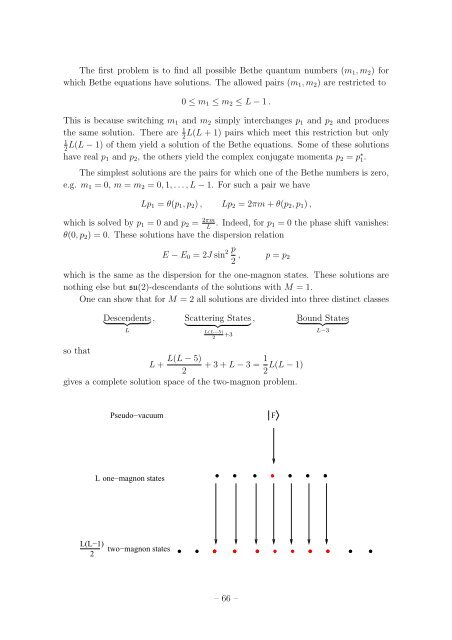Student Seminar: Classical and Quantum Integrable Systems
Student Seminar: Classical and Quantum Integrable Systems
Student Seminar: Classical and Quantum Integrable Systems
You also want an ePaper? Increase the reach of your titles
YUMPU automatically turns print PDFs into web optimized ePapers that Google loves.
The first problem is to find all possible Bethe quantum numbers (m 1 , m 2 ) for<br />
which Bethe equations have solutions. The allowed pairs (m 1 , m 2 ) are restricted to<br />
0 ≤ m 1 ≤ m 2 ≤ L − 1 .<br />
This is because switching m 1 <strong>and</strong> m 2 simply interchanges p 1 <strong>and</strong> p 2 <strong>and</strong> produces<br />
the same solution. There are 1 L(L + 1) pairs which meet this restriction but only<br />
2<br />
1L(L − 1) of them yield a solution of the Bethe equations. Some of these solutions<br />
2<br />
have real p 1 <strong>and</strong> p 2 , the others yield the complex conjugate momenta p 2 = p ∗ 1.<br />
The simplest solutions are the pairs for which one of the Bethe numbers is zero,<br />
e.g. m 1 = 0, m = m 2 = 0, 1, . . . , L − 1. For such a pair we have<br />
Lp 1 = θ(p 1 , p 2 ) , Lp 2 = 2πm + θ(p 2 , p 1 ) ,<br />
which is solved by p 1 = 0 <strong>and</strong> p 2 = 2πm.<br />
Indeed, for p L<br />
1 = 0 the phase shift vanishes:<br />
θ(0, p 2 ) = 0. These solutions have the dispersion relation<br />
E − E 0 = 2J sin 2 p 2 , p = p 2<br />
which is the same as the dispersion for the one-magnon states. These solutions are<br />
nothing else but su(2)-descendants of the solutions with M = 1.<br />
One can show that for M = 2 all solutions are divided into three distinct classes<br />
Descendents<br />
} {{ } , Scattering States , Bound<br />
} {{ }<br />
} {{ States }<br />
L<br />
L(L−5)<br />
L−3<br />
+3 2<br />
so that<br />
L(L − 5)<br />
L + + 3 + L − 3 = 1 L(L − 1)<br />
2<br />
2<br />
gives a complete solution space of the two-magnon problem.<br />
Pseudo−vacuum<br />
F<br />
L one−magnon states<br />
01<br />
01<br />
01<br />
01<br />
01<br />
01<br />
01 01<br />
01<br />
01 L(L−1)<br />
2<br />
two−magnon states<br />
0 0 1<br />
01<br />
01<br />
0<br />
0 1 0<br />
01<br />
1<br />
101 0 1<br />
1<br />
01 0<br />
01 01 01 01<br />
0 1<br />
1<br />
01<br />
1 01<br />
0 1<br />
– 66 –

















